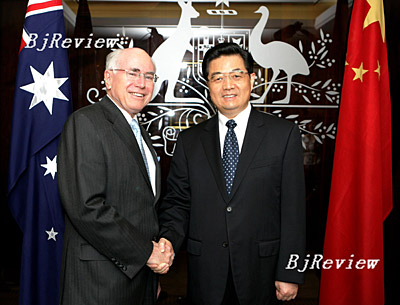
Chinese President Hu Jintao's state visit to Australia and his participation in the Asia-Pacific Economic Cooperation (APEC) summit earlier this month were diplomatic successes by several accounts, but they also highlighted ongoing challenges that China faces in bilateral ties with Australia and in multilateral regional cooperation, foreign affairs experts said.
Hu's meetings with Australian Prime Minister John Howard and APEC member leaders during his September 3-9 trip boosted bilateral ties between China and Australia and among APEC members in the areas of trade, energy and environmental policy.
China and Australia have a complimentary trade relationship, which means that their cooperation on trade and economic issues will be well developed in the future, said Shen Shishun, Director of Department for Asia-Pacific Security and Cooperation, China Institute of International Studies (CIIS). But both countries face challenges in their talks on free trade areas, both bilaterally and under the APEC framework. Because they are at different levels of development, especially in agriculture and the prices of agricultural products, the two sides need to find solutions through compromise, he said.
As for APEC itself, big economic challenges lay ahead, Shen said. "APEC member economies are still working toward the goal of seeking common ground and cohesion from different stances, while the EU and the North America Free Trade Area had already fulfilled the task," he said. "APEC has fallen behind of them on this level, due to historic and geographic reasons."
But APEC is marching ahead step-by-step through these difficulties, Shen said, adding that most member economies are voluntarily reducing their tariffs according to their own situations.
Back at home, Foreign Minister Yang Jiechi called Hu's trip to Australia a major diplomatic move by China in the Asia-Pacific region. China and Australia reached a consensus on strengthening mutual political trust, deepening trade and economic cooperation, broadening humanistic exchanges and enhancing communication and coordination in international and regional affairs, Yang said, according to Xinhua News Agency reports.
Hu's trip to Australia marked the 35th anniversary of establishment diplomatic relations between China and the country. Before the visit, Liu Jieyi, Director of the Department of North American and Oceanian Affairs at the Ministry of Foreign Affairs, said that high-level visits between the two countries had become more frequent in recent years in light of the rapid development of their trade and economic cooperation. Australian Prime Minister John Howard has paid six state visits to China.
China is Australia's second largest trade partner, and Australia is China's ninth largest trade partner. The bilateral trade volume between China and Australia in 2006 was more than $32.9 billion, according to China's Ministry of Commerce. During the first seven months in 2007, it totaled $23.3 billion, an increase of almost 35 percent over the same period last year. With bilateral trade increasing at average 30 percent to 50 percent per year, China soon will become Australia's biggest trade partner.
| 